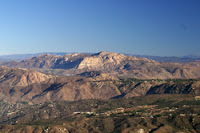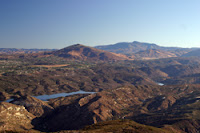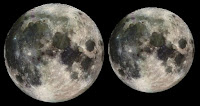
In a post yesterday (Ants), I mentioned one of the beasties we have out here in the near-desert chapparal: the tarantula hawk. I think it's high time I introduced y'all to this little bug...
When I first saw one of these quite beautiful insects a few years ago, I was very curious as to what it might be. The photo at right (not mine!) doesn't do this insect justice at all. The body is a very bright blue, and the wings and antennae are an even brighter reddish orange color. They are bright enough to catch your eye at quite a long distance, and they're not a bit shy.
I could tell by examination that they belonged to the wasp family, and it didn't take much googling to find out what they were: members of the wasp family Pompilidae (spider wasps), in the genera Pepsis and Hemipepsis. I don't know the exact species we have here; apparently there are many species and they're difficult to tell apart. But very shortly after discovering what they are, I read this about them:
The sting, particularly of Pepsis formosa, is among the most painful of any insect. Commenting on his own experience one researcher said, "You will curse your mother for ever having you." Another described, "...immediate, excruciating pain that simply shuts down one’s ability to do anything, except, perhaps, scream. Mental discipline simply does not work in these situations." Yet another said, "It's not like things that make you swear and say bad things about somebody's mother. These things, when you get stung, you might as well lie down and scream. Why not? It takes your attention off the pain." Rightly so, it is lies almost at the top of the list in Schmidt Sting Pain Index. Although the sting is quite painful the effect is reported to last only a few minutes and is less lethal than that of the honey bee.
Now I'd never heard tell of the "Schmidt Sting Pain Index", but it didn't sound good. A quick look on Wikipedia got me this:
Schmidt Sting Pain Index or The Justin O. Schmidt Pain Index was created by Justin O. Schmidt, an entomologist. Having been stung by almost everything, Schmidt created (on his own time) an index to compare the overall pain of insect stings on a four-point scale.
* 1.0 Sweat bee: Light, ephemeral, almost fruity. A tiny spark has singed a single hair on your arm.
* 1.2 Fire ant: Sharp, sudden, mildly alarming. Like walking across a shag carpet & reaching for the light switch.
* 1.8 Bullhorn acacia ant: A rare, piercing, elevated sort of pain. Someone has fired a staple into your cheek.
* 2.0 Bald-faced hornet: Rich, hearty, slightly crunchy. Similar to getting your hand mashed in a revolving door.
* 2.0 Yellowjacket: Hot and smoky, almost irreverent. Imagine WC Fields extinguishing a cigar on your tongue.
* 3.0 Red harvester ant: Bold and unrelenting. Somebody is using a drill to excavate your ingrown toenail.
* 3.0 Paper wasp: Caustic & burning. Distinctly bitter aftertaste. Like spilling a beaker of Hydrochloric acid on a paper cut.
* 4.0 Pepsis wasp: Blinding, fierce, shockingly electric. A running hair drier has been dropped into your bubble bath (if you get stung by one you might as well lie down and scream).
* 4.0+ Bullet ant: Pure, intense, brilliant pain. Like walking over flaming charcoal with a 3-inch nail in your heel.
Oh, boy. I'm real familiar with what it feels like to be stung by a sweat bee and a fire ant. The latter, especially, is not a lot of fun. And these bugs are very low on this scale...
That's enough to get me to be careful when I'm in the vicinity of tarantula hawks. As luck would have it, just after I discovered the pain potential in my insectly neighbors (this was a few years ago), I was outside doing some tractor work for a friend down the road from us. As I was merrily put-putting along on my Kubota, a tarantula hawk swooped around my left side, bobbled around right in front of me, and ... landed on my right arm. I know enough about the behavior of wasps to know that this thing wasn't really trying to attack me — especially if I did nothing to threaten it. But it was a little ... challenging ... to not react in this situation. In the end, though, this was quite rewarding: I stopped using my right arm to steer, brought the tractor to a halt, and had about 30 seconds of right-in-my-face observation time on this bug. And I have to tell you, it was one of the most interesting and most beautiful insects I've ever been able to see so close up. Still, I was happy when it took off, and left me alone.
A couple of years later, we spotted another tarantula hawk with a tarantula, wandering all over the side of our house trying to find a place to hide it. The tarantula hawks don't eat tarantulas (they're nectar feeders), but the females will sting and paralyze a tarantula to provide a nice cozy home for their kids:
A female wasp finds a tarantula by smell. Generally, she scampers across the ground to locate a burrow. She will enter the burrow and expel the spider, then attack it. She may also encounter a male tarantula during his search for a mate. In an attack, the wasp uses her antennae to probe the spider, which may raise its front legs and bare its fangs. (A tarantula does not always counterattack.) She then attempts to sting the spider. She might seize the spider by a leg, flip it over on its back and sting it, or she may approach from the side to deliver a sting. Once stung, the tarantula becomes paralyzed within seconds. The condition will last for the remainder of its life. The wasp may drink the body fluids oozing from the spider’s wounds or from its mouth to replenish nutrients and water she used during the attack.
Motherhood is a lovely thing, isn't it?
A couple of strange little factoids about tarantula hawks:
Tarantula hawks are the state insect of New Mexico. What on earth were they thinking?
Tarantula hawks can become "flight-challenged" after eating fermented nectar. Drunk wasps with horribly painful stings — sounds like giving a loaded gun and car keys to a drunk, angry teenager...
You can read more about tarantula hawks, pain, and insect intoxication here, here, here, here, here, and here.





















